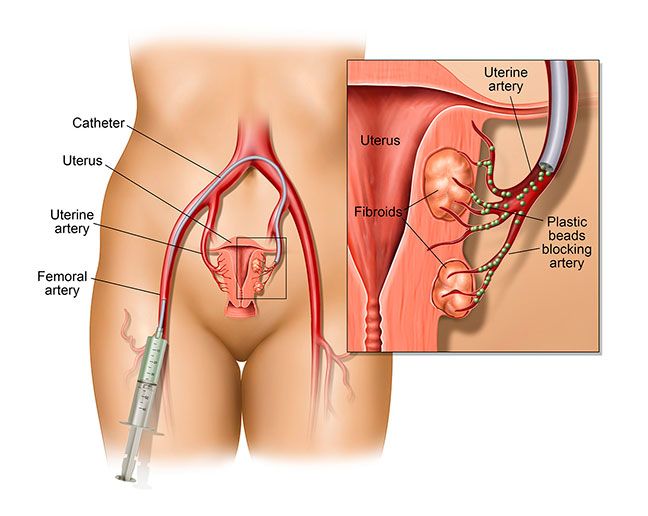Minimally-Invasive Treatment for Uterine Fibroids
Earlier only drastic surgical methods could provide relief for women suffering from uterine fibroids. Now, a revolutionary approach exists to treat fibroids without surgery or lengthy recovery periods

Overview
Uterine fibroids are noncancerous growths of the uterus that often appear during childbearing years. Fibroids aren’t associated with an increased risk of uterine cancer and almost never develop into cancer. Fibroids range in size from seedlings, undetectable by the human eye, to bulky masses that can distort and enlarge the uterus. You can have a single fibroid or multiple ones. In extreme cases, multiple fibroids can expand the uterus so much that it reaches the rib cage and can add weight.
Many women have uterine fibroids sometime during their lives. But you might not know you have uterine fibroids because they often cause no symptoms. Your doctor may discover fibroids incidentally during a pelvic exam or prenatal ultrasound
Symptoms & Diagnosis
Many women who have fibroids don’t have any symptoms. In those that do, symptoms can be influenced by the location, size, and number of fibroids.
In women who have symptoms, the most common signs and symptoms of uterine fibroids include:
- Heavy menstrual bleeding
- Menstrual periods lasting more than a week
- Pelvic pressure or pain
- Frequent urination
- Difficulty emptying the bladder
- Constipation
- Backache or leg pains
Rarely, a fibroid can cause acute pain when it outgrows its blood supply and begins to die.
Diagnosis
Uterine fibroids are frequently found incidentally during a routine pelvic exam. Your doctor may feel irregularities in the shape of your uterus, suggesting the presence of fibroids.
If you have symptoms of uterine fibroids, your doctor may order these tests:
Ultrasound. If confirmation is needed, your doctor may order an ultrasound. It uses sound waves to get a picture of your uterus to confirm the diagnosis and to map and measure fibroids.
A doctor or technician moves the ultrasound device (transducer) over your abdomen (transabdominal) or places it inside your vagina (transvaginal) to get images of your uterus.
Lab tests. If you have abnormal menstrual bleeding, your doctor may order other tests to investigate potential causes. These might include a complete blood count (CBC) to determine if you have anemia because of chronic blood loss and other blood tests to rule out bleeding disorders or thyroid problems.
Other tests include MRI, Hysterosonography, Hysterosalpingography, Hysteroscopy.
Treatment
The Endovascular & Interventional procedures performed for Uterine Fibroids treatment are
Uterine artery embolization. Small particles (embolic agents) are injected into the arteries supplying the uterus, cutting off blood flow to fibroids, causing them to shrink and die.

This technique can be effective in shrinking fibroids and relieving the symptoms they cause. Complications may occur if the blood supply to your ovaries or other organs is compromised. However, research shows that complications are similar to surgical fibroid treatments and the risk of transfusion is substantially reduced.
Uterine artery embolization is a procedure in which an interventional radiologist uses a catheter to deliver small particles that block the blood supply to the uterine body. The procedure is done for the treatment of uterine fibroids and adenomyosis. This minimally invasive procedure is commonly used in the treatment of uterine fibroids .
FAQ
Your Questions
Answered
All sizes of fibroids have been successfully embolized. The shrinkage will be felt more in fibroids smaller than a 5 – month sized pregnancy. The embolization process affects all fibroids within the uterus wherever they are located.
Most patients experience cramping pain for one or two days after embolization. Many patients go home on the afternoon of their procedure. Some patients, especially those with larger fibroids experience a low-grade fever after embolization.
Recurrence after embolization has not occurred. This is one of its major advantages over myomectomy, where fibroids which have been surgically removed often grow back.
This procedure is performed under local rather than general anesthetic. Second, nothing is cut open or removed from your body. Occasionally, we keep patients for observation, but most women return home the same day as the procedure.
Women have conceived after embolization. In fact we know of no patient who could become pregnant before embolization who could not after this procedure. Women have successfully carried babies to term after embolization. Ask your doctor about the risks to fertility associated with major surgery such as myomectomy before deciding upon embolization.
Yes. Most insurance companies cover the procedure to treat fibroids by IR. Your physician can discuss your eligibility with you when discussing your treatment plan.
No. Due to the small size of the catheter insertion point, most patients do not experience any scarring at all.

TECHNOLOGY
Devices for IR Procedures

Torcon NB® Advantage Catheter
Used in angiographic procedures by physicians trained and experienced in angiographic techniques.

Contour™ PVA Embolization Particles
The Contour PVA Embolization particles are small and irregular flakes of polyvinyl alcohol, which are used for permanent occlusion within a blood vessel. The Contour PVA Embolization Particles have been proven to be safe and effective in many clinical scenarios for decades.

Direxion HI-FLO™ Torqueable Microcatheters
Experience the powerful combination of Direxion™ Microcatheter and Fathom™ Guidewire to save time, treat more patients, and deliver better outcomes.
Dr Charudutt Sambhaji
Dr Charudutt Sambhaji MBBS, M.D. is an alumnus of Goa Medical College and, is Vascular surgeon & Interventional Radiologist. He has practised and also taught at the KMC Manipal where he was instrumental in setting up The Musculoskeletal Radiology Unit at Kasturba Medical College & hospitals, Manipal, Udupi which performs advanced diagnostic and image-guided musculoskeletal procedures.
- +91 7745 822 446
- appointment@flowclinic.com
- Manipal Hospital Goa, Dr. E Borges Road, Dona Paula, Panaji, Goa-403004
- Amplification by: Amplify-Intelligent Marketing


